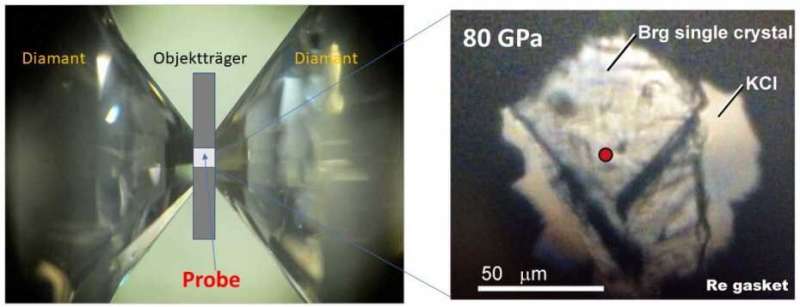Earth's interior is cooling faster than expected

Researchers at ETH Zurich have demonstrated in the lab how well a mineral common at the boundary between the Earth's core and mantle conducts heat. This leads them to suspect that the Earth's heat may dissipate sooner than previously thought.
The evolution of our Earth is the story of its cooling: 4.5 billion years ago, extreme temperatures prevailed on the surface of the young Earth, and it was covered by a deep ocean of magma. Over millions of years, the planet's surface cooled to form a brittle crust. However, the enormous thermal energy emanating from the Earth's interior set dynamic processes in motion, such as mantle convection, plate tectonics and volcanism.
Still unanswered, though, are the questions of how fast the Earth cooled and how long it might take for this ongoing cooling to bring the aforementioned heat-driven processes to a halt.
One possible answer may lie in the thermal conductivity of the minerals that form the boundary between the Earth's core and mantle.
This boundary layer is relevant because it is here that the viscous rock of the Earth's mantle is in direct contact with the hot iron-nickel melt of the planet's outer core. The temperature gradient between the two layers is very steep, so there is potentially a lot of heat flowing here. The boundary layer is formed mainly of the mineral bridgmanite. However, researchers have a hard time estimating how much heat this mineral conducts from the Earth's core to the mantle because experimental verification is very difficult.
Now, ETH Professor Motohiko Murakami and his colleagues from Carnegie Institution for Sciencehave developed a sophisticated measuring system that enables them to measure the thermal conductivity of bridgmanite in the laboratory, under the pressure and temperature conditions that prevail inside the Earth. For the measurements, they used a recently developed optical absorption measurement system in a diamond unit heated with a pulsed laser.
"This measurement system let us show that the thermal conductivity of bridgmanite is about 1.5 times higher than assumed," Murakami says. This suggests that the heat flow from the core into the mantle is also higher than previously thought. Greater heat flow, in turn, increases mantle convection and accelerates the cooling of the Earth. This may cause plate tectonics, which is kept going by the convective motions of the mantle, to decelerate faster than researchers were expecting based on previous heat conduction values.
Murakami and his colleagues have also shown that rapid cooling of the mantle will change the stable mineral phases at the core-mantle boundary. When it cools, bridgmanite turns into the mineral post-perovskite. But as soon as post-perovskite appears at the core-mantle boundary and begins to dominate, the cooling of the mantle might indeed accelerate even further, the researchers estimate, since this mineral conducts heat even more efficiently than bridgmanite.
"Our results could give us a new perspective on the evolution of the Earth's dynamics. They suggest that Earth, like the other rocky planets Mercury and Mars, is cooling and becoming inactive much faster than expected," Murakami explains.
However, he cannot say how long it will take, for example, for convection currents in the mantle to stop. "We still don't know enough about these kinds of events to pin down their timing." To do that calls first for a better understanding of how mantle convection works in spatial and temporal terms. Moreover, scientists need to clarify how the decay of radioactive elements in the Earth's interior—one of the main sources of heat—affects the dynamics of the mantle.
More information: Motohiko Murakami et al, Radiative thermal conductivity of single-crystal bridgmanite at the core-mantle boundary with implications for thermal evolution of the Earth, Earth and Planetary Science Letters (2021). DOI: 10.1016/j.epsl.2021.117329
Journal information: Earth and Planetary Science Letters
Provided by ETH Zurich





















